 | |
|
13 April 2006 The Situationist City
To me it seems a worthwhile attempt to understand the 'artistic' phase of the Situationist International (as opposed to the later, revolutionary/political phase). And in particular, it talks extensively about the Situationists' attitude to cartography. "Maps had traditionally been made by those wishing to impose order upon the city... In their maps, by stark contrast, Debord and Jorn attempted to put the spectator at ease with a city of apparent disorder, exposing the strange logic that lay beneath its surface... the situationist maps described an urban navigational system that operated independently of Paris's dominant patterns of circulation." "'With the aid of old maps, aerial photographs and experimental drifts, one can draw up hitherto lacking maps of influences,' Debord insisted." I like this latter quote not least because old maps, aerial photographs and (GPS-enabled) experimental drifts are the tools we're using to draw up open maps to everywhere. Thus far, the buzz around open geodata has largely focused on providing better GIS - the raw material either for consumer webmaps, or for MySociety-like civic GIS. This is all great. But we should also be looking to redefine cartography for the Internet age. Maps that answer the question of "what's it like?" rather than "where is it?"... maps where scale and projection are no longer the key considerations. Through the web, we can deliver maps that inspire rather than simply inform. This is, of course, the old SI/Lettrist concept of psychogeography. Headmap has been ploughing this furrow for some time and even Google, I think, is realising that pushpins-in-a-streetmap can only get you so far. Web 2.0 projects like Mappr, Wayfaring, even Google Earth are great in their own way, but don't really advance our understanding of what a map can do. So we have to actually build a psychogeographical map - because real artists ship, though Steve Jobs would inevitably be denounced by pro-Situs as a perpetrator of recuperation on a grand scale. But then, as Sadler points out, the SI was always good on the theory, not so good on the delivery. CommentsThat Debord quote's great! I think I/we might have to nab it for OpenStreetMap.org :) The full quote (which I can't link to, so you'll have to google the first few words) is also pretty good. Posted by Tom Carden on 13.4.06 09:34 Very interesting site! I'm an artist from Canada. I'm going to Buenos Aires in May/June 2006 to work on a video / mapping project. I'm interested in connecting with other people into Psychogeography - particularly based in Argentina. Posted by Nikki Forrest on 23.4.06 15:27 im still trying to understand the influence of SI on architecture in terms of design...... Posted by javeria masood on 18.2.08 14:30 | |
 I've recently finished reading Simon Sadler's
I've recently finished reading Simon Sadler's 